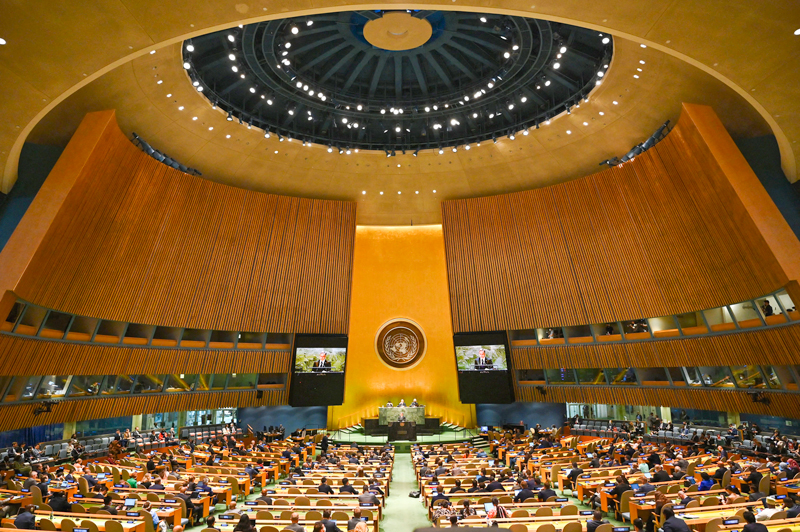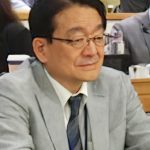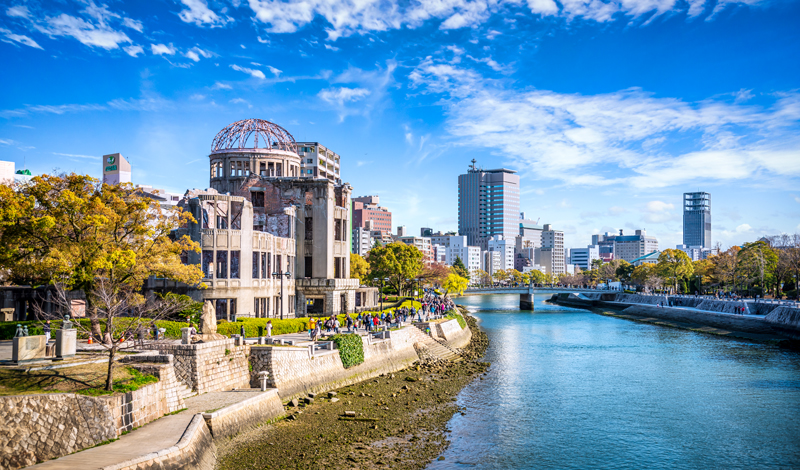The Soka Gakkai recently launched “Transforming Human History,” a campaign to encourage engagement and inspire confidence that change is possible. It covers three areas that will determine the future of life on our planet: nuclear weapons abolition, education for all and climate action. These issues are the focus of Ikeda Sensei’s 2022 peace proposal.
The World Tribune will cover education for all and climate action in the next several months.
Everything you treasure could be reduced to ashes in a moment. There is more danger of a nuclear weapon being used now—whether deliberately or by accident—than at any time since the Cold War. So long as these indiscriminate weapons of mass destruction exist, humanity lives under the constant threat of annihilation.
At the same time, through the momentum created by countless concerned individuals around the world, nuclear weapons have now been outlawed by the Treaty on the Prohibition of Nuclear Weapons (TPNW), which came into force in 2021. So far, 86 nations have signed the treaty. This does not yet include any of the nuclear-armed states. Today’s youth can be the generation that finally rids the world of these inhumane weapons.
By the Numbers
67,500
Number of nuclear missiles built, 1951 to present. Currently some 14,000 nuclear warheads exist in the world.
7,000
Ground temperatures, in fahrenheit, caused by the 15-kiloton Hiroshima atomic bomb, comparable to those found on the surface of the sun. Many of today’s nuclear weapons are at least 100 times more powerful.
2,000+
Number of nuclear test explosions conducted around the world to date, resulting in chronic illnesses and cancers in people exposed to the fallout. Large swaths of land remain radioactive and unsafe.
66
Number of States Parties to ratify the Treaty on the Prohibition of Nuclear Weapons (TPNW), as of July 2022. A further 23 states have signed but not yet ratified, making a total of 89 states (or 45% of all nation-states worldwide).
5
Number of nuclear-weapons-free zones (NWFZ). A NWFZ is a region in which countries commit to not manufacture, acquire, test or possess nuclear weapons. Four NWFZs span the entire Southern Hemisphere.
4
Countries that have given up possession and manufacture of nuclear weapons (South Africa, Ukraine, Belarus and Kazakhstan).
(For more information on “Transforming Human History” campaign, go to www.sokaglobal.org/campaigns/transforming-human-history/)

Shared Responsibility for a Nuclear-Free World
In an interview with Thalif Deen at IDN-InDepthNews, Hirotsugu Terasaki, SGI director general of peace and global issues, discusses the frightening risk posed by nuclear weapons and key points to guide humanity out of this predicament toward a brighter future. The full interview can be read at indepthnews.net.

IDN: How effective is the global campaign by religious and faith-based organizations—and by anti-nuclear activists—in raising public awareness of the threat of an impending nuclear disaster? What are the SGI’s plans in this regard?
Hirotsugu Terasaki: The future of humankind rests on disarmament and the abolition of nuclear weapons. This is a matter that concerns all people everywhere. That is why I firmly believe we cannot leave this to the political, diplomatic and military experts. That’s not to say that expert debate doesn’t play a vital part in the process, but there is the risk of remaining deadlocked should discussions take place within these circles alone.
When we do find ourselves at an impasse, it is important to return to our starting point. What is that starting point, that initial point of departure, when it comes to the issue of nuclear abolition? Surely it is the lived reality of a nuclear catastrophe as experienced by hibakusha in Hiroshima, Nagasaki and throughout the world, and the human spirit that enables us to empathize with the suffering they have endured. There is a danger that if deliberations are conducted without this acute awareness they will come to a standstill or become irrelevant.
The educational community, the media and civil society must use all tools available to communicate just how inhumane nuclear weapons are, ensuring this understanding is transmitted to future generations. While the effects of such efforts may not be immediately apparent, I am confident that raising public awareness on this issue, especially now, at a time when there is a heightened risk that nuclear weapons will actually be used, will, in the long run serve as a powerful driving force for progress.
Proof of this can be found in the path to realizing the Treaty on the Prohibition of Nuclear Weapons (TPNW), in which the Humanitarian Initiative worked to focus attention on the inhumane nature of nuclear weapons, thus helping to shift global public opinion and ultimately leading to the adoption of the treaty at the United Nations in 2017. …
Solidarity can be a great strength, especially in times of global crisis. If civil society and faith communities continue to unite their voices toward the achievement of a grand objective, they can be an unstoppable force for change in the world.
On the occasion of the current NPT Review Conference, the SGI joined more than 100 organizations—Faith Communities Concerned about Nuclear Weapons—in issuing a joint statement, which was read at the session allocated for NGO presentations. Allow me to introduce a portion of it here, which lays out, in plain language, the approach taken by civil society and faith communities:
As people of faith, we are here to remind you, delegates of the NPT Review Conference, of our shared humanity. … We know that nuclear weapons, whether used by design or accident, will destroy the world as we know it and cause tremendous suffering to many people, as testified by the hibakusha and those from affected communities. Nuclear weapons are incompatible with our fundamental values of respect for human dignity; their continued role in so-called national security should not be tolerated.
All of us, as leaders, delegates, civil society and faith communities, share the moral and ethical responsibility of realizing a world without nuclear weapons, knowing that the possibility lies in our hands. It is up to each of us to enact this mission, and history will surely show that we took the right course.
This year marks 65 years since second Soka Gakkai President Josei Toda (1900–58) made a declaration calling for the abolition of nuclear weapons, entrusting this task to the youth of the time and to subsequent generations.
In the spirit of making this year, this moment now, a crucial milestone toward the realization of a world without nuclear weapons, we are committed to redoubling our efforts to promote grassroots educational activities, broaden networks of solidarity and bring the voices of civil society to the United Nations. We want to ensure that members of the next generation throughout the world inherit the vow for nuclear abolition.
‘True Societal Change Comes From the People’

Emma Pike
Boston
Nine years ago, as a student, I read the book Choose Hope: Your Role in Waging Peace in the Nuclear Age, a dialogue between Ikeda Sensei and David Krieger, founder of the Nuclear Age Peace Foundation. At the time I was vaguely aware of the destructive nature of nuclear weapons, but it felt like a problem far removed from me.
When I read this dialogue, however, I discovered the true extent of the horror of nuclear weapons and that I, as an individual, have an important role to play in eliminating them from the world. By the time I finished the book, I was convinced: I must do something about it. I vowed to work in the nuclear weapons abolition field.
Last year, I renewed this vow and, through my prayer, faith and effort, I’ve since been working as an activist and campaigner. People I have regarded for years as my heroes in nuclear abolition and disarmament I now refer to as colleagues.
I feel it’s extraordinary that 65 years after second Soka Gakkai President Josei Toda delivered his Declaration for the Abolition of Nuclear Weapons, Sensei is still taking swift, bold action to realize his mentor’s wish. He recently sent a concrete proposal to the Nuclear Non-Proliferation Treaty (NPT) Review Conference calling for the five nuclear-weapons states to commit to the principle of “no first use” of nuclear weapons (see September Living Buddhism). In reading it, I felt that Sensei deeply and thoroughly understands the current nuclear weapons architecture, the NPT treaty itself and the current global security climate. He has such a sophisticated understanding of these things, and he is thoroughly prepared.
For me, Sensei is the example of what it means to live based on a true vow, to live every day, every hour, in an effort to respond to one’s mentor. I feel so fortunate to call Sensei my mentor.
I was fortunate to attend the NPT conference this year. If there is one thing I learned, it is that true societal change only comes from the people. Even at high levels like the U.N., for any positive change to move forward, citizens are key. This is why we practice Buddhism—to transform our society through our own human revolution. Our propagation efforts are not separate from this effort to enact societal change. In fact, I think our propagation efforts are the very foundation. We practice and spread this Buddhism in order to truly build a more peaceful world.
I’m determined to strive every day to take on this mission to completely eliminate nuclear weapons—a mission we have inherited from President Toda and Sensei—and to do so in a way that is most true to myself.
You are reading {{ meterCount }} of {{ meterMax }} free premium articles

